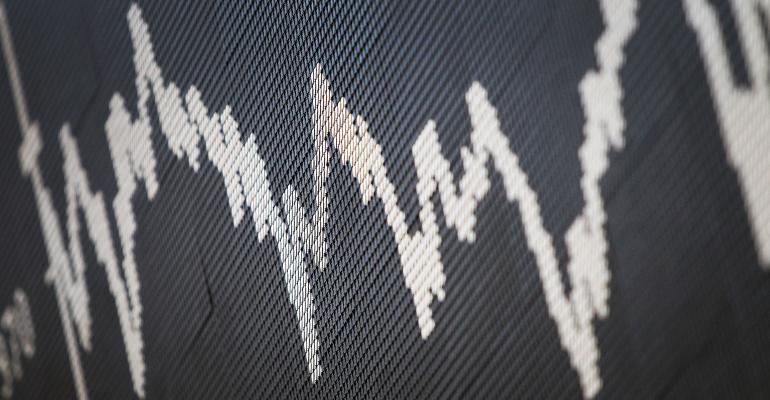(Bloomberg) -- Investors are losing their ability to resist a stock rally that much of Wall Street is convinced is doomed.
More than $12.6 billion has been sent to equity exchange-traded funds in April, the largest influx since January and more than twice the rate of February and March. Money is pouring into stocks as fast as it’s being yanked out of cash: ultra-short duration ETFs are on track for their first monthly outflow since January, data compiled by Bloomberg show.
Spigots are turning back on at a time of fairly intense skepticism among the pundit class. To the ever-elongating list of potential obstacles, investors were treated in the last few days to dour tidings in both the Federal Reserve Beige Book report and the Philadelphia Fed’s manufacturing index.
While earnings have been broadly positive, results from Fastenal Co. to Ally Financial Inc. and even Tesla Inc. hinted the US consumer is beginning to buckle. Meanwhile, the S&P 500 is butting up against a level where previous attempts to break out of its sideways march have run out of steam.
Does a case for optimism exist? Yes, mainly in how widespread the bearishness remains — by some measures, it’s the most extreme since 2009. Despite the souring risk appetite after aggressive Fed tightening and banking system turmoil, the S&P 500 has still come nowhere near revisiting its worst levels of last year.
“We haven’t had a new low since October, people aren’t hearing artillery shells landing anymore, so they’re peeking heads out of foxholes,” said George Pearkes, global macro strategist at Bespoke Investment Group. “It may seem silly to attribute large flows of capital to something as simple as not seeing a drop in some time. But that’s how we see flows and sentiment operating in practice, even if it is simple and reductive.”
The S&P 500 finished the week a hair lower, leaving this year’s gain above 7.5%. Meanwhile, volatility continued to drain from the bond market — the 10-year Treasury yield added just four basis points in the week, the smallest swing since before Silicon Valley Bank’s sudden collapse last month.
A similar dynamic prevailed in credit, where few signs of surface-level stress exist despite some red flags. Both investment-grade and high-yield spreads remain well below the peaks of last summer, even as ratings agencies downgrade corporate bonds to junk status at the busiest pace since the pandemic’s outbreak in 2020.
“There’s a fear of missing out on an upside move,” said Charles Campbell, a managing director and trading desk specialist at Roth MKM. “People are also putting money in it because some believe we can have a no landing or soft economic landing scenario, which I don’t subscribe to.”
For the stock faithful, lines on charts may pose the nearest threat to hopes the rally can continue. Up four of the last six weeks to just over 4,130, the S&P 500 sits within about a hundred points of levels where rallies reversed themselves in February, November and September. At more than 18 times annual earnings, the index isn’t cheap, particularly with analysts expecting profits to fall in 2023.
While economic data remains mixed, concern over the prospect of a credit crunch spurred by March’s banking stress is proving hard to shake. The Fed’s Beige Book survey of regional business contacts found economic activity little changed and said several districts noted banks tightened lending standards amid increased uncertainty and concerns about liquidity. The Philly Fed factory index fell to minus 31.3, a level that has preceded past recessions.
“We still see a weakening environment for risk assets and would be playing defense,” Sameer Samana, Wells Fargo Investment Institute’s senior global market strategist, who expects the Fed to stick to its inflation-fighting stance. “Stocks have made their way close to the upper end of their trading range. We view that disconnect as an opportunity to pull further risk off the table.”
A handful of earnings reports also gave reason for pause, even as most companies managed — as always — to deliver results that beat analyst predictions. Construction materials supplier Fastenal said growth in March sales slowed to the lowest since June 2021. Ally Financial’s profit plummeted as it made fewer auto loans and put aside additional provisions to cover consumer defaults. Tesla slumped 11% on the week after Chief Executive Elon Musk indicated he’ll keep cutting prices to stoke demand.
Read more:
Wall Street Is Getting a New Fear Gauge as 0DTE Mutes VIX
Day Traders Lose $358,000 Per Day Gambling on Zero-Day Options
Selling Put Options Paying Out Big With S&P 500 Walking Highwire
Consistent with rising risk appetites among retail ETF buyers, a gauge of adviser sentiment kept by Investors Intelligence known as the bull/bear ratio climbed for a fourth week to its highest since the start of 2022 — the month that marked the beginning of the current bear market. The indicator hit 1.0 in October, near its financial-crisis low, just before stocks began their current rally.
“In late October, we concluded that sentiment was so bearish it had to be bullish,” wrote Ed Yardeni, founder of Yardeni Research Inc. Right now, “sentiment may not be bullish enough to work as a contrary indicator for the bears, nor bearish enough to work for the bulls,” he said. “A stalemate in their tug-of-war may be the result until the recession and debt-ceiling debates are resolved, probably in early June. Then, the current bull market is likely to resume, in our opinion.”
--With assistance from Carly Wanna.





